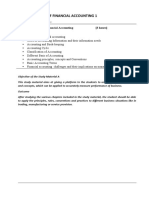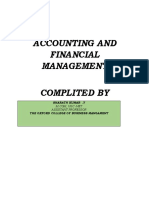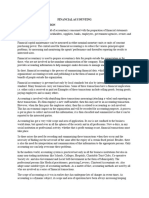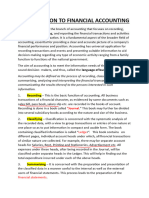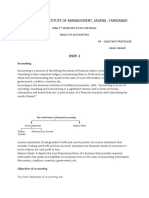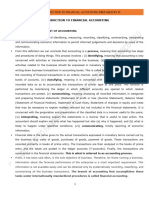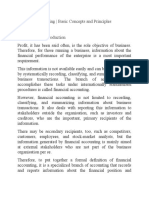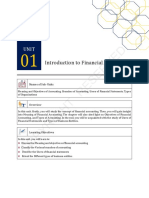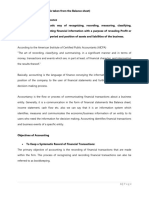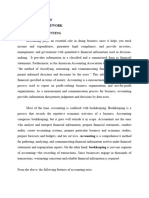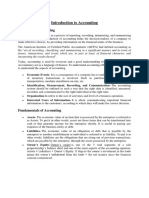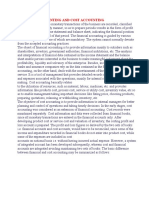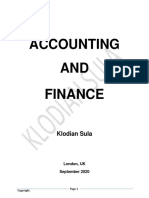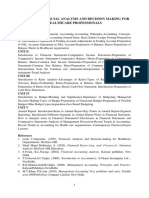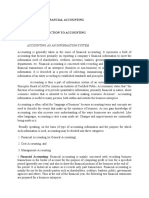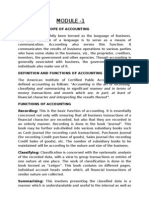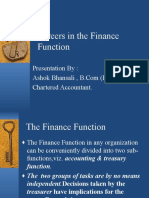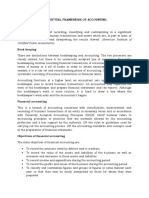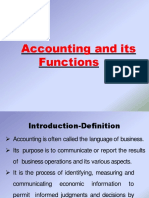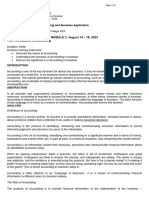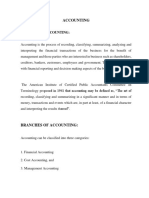GAURAV
GAURAV
Uploaded by
Saurabh MishraCopyright:
Available Formats
GAURAV
GAURAV
Uploaded by
Saurabh MishraOriginal Description:
Copyright
Available Formats
Share this document
Did you find this document useful?
Is this content inappropriate?
Copyright:
Available Formats
GAURAV
GAURAV
Uploaded by
Saurabh MishraCopyright:
Available Formats
INTRODUCTION
Accounting discipline deals with measurement of economic activities affecting inflow and outflow of economic resources to develop useful information for decision making. At household level information about outflow and inflow of cash resources helps -.0 assess financial position and plan household activities. At Government level, information about inflow from taxes (direct as well as indirect) and expenditure on various activities (developmental and non developmental) is needed for planning and budgeting. Although accounting can be discipline has universal applicability, but its growth is closely associated with the developments in the business world. Thus to understand accounting as a field of study for universal application, it is best identified with recording of business transaction and thereby creating economic information about business enterprises to facilitate decision making.
BRANCHES OF ACCOUNTING
Financial Accounting: It primarily concentrates on creation of financial
information for external user groups such as creditors, investors, lenders and so on. It deals with business events which have already occurred and is, therefore, historical in nature. Traditionally, the aim was to develop information about income and financial position on the basis of events which had taken place during a period of time. Recent trend in corporate form of organization is to provide information about cash flows and earnings per sh^e also as part of published financial statements. Management Accounting The information provided by the financial accounting system is significant but not sufficient for smooth orderly and efficient conduct of business. Management needs more information to discharge its function of stewardship, planning, control and decision-making. As information needs of management vary from enterprise to
enterprise, the grouping and reporting of information takes different forms. Trie different ways of grouping information and preparing reports as desired by managers for discharging their functions are referred to a management accounting. Management accounting provides information to the management not only about cost but also revenue, profit, investment etc., for managing business more efficiently and effectively. A very important component of management accounting is cost accounting which deals with cost ascertainment and cost control. MEANING OF FINANCIAL ACCOUNTING Measurement of accounting information involves three basic steps as per the traditional definition of accounting by the American Institute of Certified Public Accounts (AICPA) which defines accounting as "the are of recording, classifying and summarizing in a significant manner and in terms of money, transaction- and events which are negative part atleast of financial character and interpreting the results thereof. On this basis of above information, Accounting or more precise financial accounting can be basically divided into two parts", A. Creation of financial information. B. Use of financial information
A. Creation of financial information:
1. Recording: The process of creation of financial information starts with the occurrence of a business transaction which can be Qualified. The transaction is evidenced by some document such as Sales bill, Pass book, Salaries slip etc., The systematic record of those transactions
is chronological order (i.e. the order in which they occur ) is made in a book called JOURNAL BOOK. The four basic questions need to be addressed while recording namely, what to record, when to record, how to record and at what value to record?
What to record? Since-accounting is regarded as language of the business, it should systematically record all the transaction and events which affect the results of business and ignore the person transaction of the proprietor. Before recording in the journal book, all business transaction expressed in terms of money. Consequently business activities which cannot be expressed in terms of money such as strikes, changes in the composition of board of directors etc., are not recorded. Thud decision makers will get informa^on only about money aspects of the business enterprise from a accounting records. When to record? Usually business transaction is recorded only when it has occurred. Thus accounting is basically historical in nature. How to record? Usually business transaction has two aspects and both these are recorded by passing analysts entry in an journal book. This system of recording is called double entry book keeping system. At what value to record? To record occurrence of an event in journal book, decision about the value of the transaction is needed. A number of different valuation bases are used in accounting in varying degrees and include historical cost, current cost, realizable value and present value.
2. Classifying:
After recording monetary transactions in the journal book, next step is to classify the recorded information into related groups to put information in compact and usable forms. For e.g., all transactions involving cash inflows (receipts) and cash outflows (payments) can be grouped to develop useful information is called ledger book. Mechanism used for classification of recorded information is to open accounts which are called ledger accounts.
3. Summarizing:
Basic aim of accounting is to create financial information in a form which will be useful to the decision makers. To achieve this end, accounts containing classified information in the ledger book are balanced. After balancing of the ledger book, account balances are listed statement giving names of theses accounts and their balance is called " TRIAL BALANCE " on the basts of trail balance, summaries are prepared to give useful information about the financial results during a time period and the financial position at a point of time. Reporting of summarizes of the business transaction is done in the form of financial statements which are known as FINAL ACCOUNTS. According to international Accounting standard - 1 the term financial statements covers balance sheet, income statements or profit and loss accounts, notes and other statements and explanatory material which are identified as being part of the financial statements. The process of creation of financial information can be summarized as follows:
Analysis of business transaction evidenced by source B. document Useatements:
Recording Journal Book
Classificati on in ledger book
Summariza tion first in trial balance and then in financial statements
Financial statements prepared by a business enterprise are published and are available to the decision makers. Sound
division making requires analysis and interpretation of these financial statements. A very commonly used tool for financial analysis is ratio analysis. However, there are other tools which are used by the decision makers to undertake analysis. The widely used tools for carrying out analysis are : Cash flow statement Fund flow statement Ratio analysis Comparative statement Common size statement
OBJECTIVES OF ACCOUNTING
The main objective of accounting are as follows:
The main records of business
In accounting, systematic record of monetary aspects of business events are maintained. The first step in preparation of financial statements. This is referred to as book-keeping.
Calculation of profit or loss
To calculate profit earned or losses suffered during a period of time, a business enterprise prepares an Income Statement. It is also referred to a trading and profit and loss account.
Depiction of financial position:
In addition to profit (or loss), sound decision-making requires information about the financial position of a busiriess enterprises. To depict financial position of a business, financial position statement is prepared. On the one hand, it gives details of resources owned by
the business enterprise. Resource owned are termed as assets. On the other hand it contains the information about obligations of business. Obligation of the business towards outsiders and owner are referred to as liabilities and capital respectively. Financial position statement is also termed as balance sheet which provide information about sources of finance (e.g. outside liability and owners equity) and the resources (eg. assets) of the business.
To portiay the liquidity position
Financial reporting should provide information about how an enterprise obtains and spends cash, about its borrowing and repayment of borrowing about its capital transactions, cash dividends and other distribution of resources by the enterprise to owners and about other factors that may affect an enterprise's liquidity and solvency.
Control over the property and asset of the firm
Accounting provides up-to-date information about the various assets that the firm possess and the liabilities the firm owes so that nobody can claim a payment which is not due to him.
To file tax returns
This is the objective which really hardly needs emphasis. The credible accounting records provide the best bases for filing returns of both, direct as well as indirect taxes.
DEFINITION OF MANAGEMENT ACCOUNTING
The accounting activity can be classified into two parts. Financial Accounting and Management Accounting. Though both of them are interlinked, Management accounting is future oriented, dynamic and is made to be decisive and control relevant. International Federation of Accountants (IFAC) defined Management Accounting process as "the process of identification, measurement, accumulation, analysis, preparation, interpretation and communication of information both financial and operating used by management to plan, evaluate and controJ within an organisation and to assure use of and accountability for its resources.
FUNCTIONS OF MANAGEMENT ACCOUNTING
Management Accountant is one of the best assets for management. His contribution has been growing with passage of time. He will continue to deliver the goods in a magnificent manner in future with varied experiences. Scope is expanding and managements of various sectors are benefiting. Excerpts from the "Preface to Statements on International Management Accounting" issued oy the international Federation of Accountants in February 1987 are reproduced below: "Management Accounting is used by management to: Plan - to gain an understanding, to expected business transactions and other economic events and their impact on the organisation, and to use this understanding as a basis for
a course of action to be followed by the organisation in the future; Evaluate - to judge the implications of various past and/or future events; Control - to ensure the integrity of financial information concerning an organisation's activities or its resources; Assure reporting accountability - to implement the system of that is and closely that aligned to to organisational the effective contributes
responsibilities
measurement of management performance" The functions of Management Accounting can be broadly classified into; (a) Periodic interval accounting reports, and (b) Ad hoc analysis of data decision making. It is increasingly felt that Management Accountants should involve themselves more and more in decision making and problem solving of organisations. The areas of decision making and problem solving are dealt in the following paras:
Strategic Management Accounting
This function helps the organisation prepare long-term plans, formulate corporate strategy and forecast and evaluate the competitors.
Investment Appraisal
This activity includes the (i) appraisal of long-term investment (ii) funding of accepted programmes projects, and (iii) post-audit of accepted programmes.
Financial Management
It deals with raising of funds for investment, managing surplus funds, controlling working capital etc,
Short-term ad hoc decisions:
This includes analysing data for taking decisions c i pricing, product introduction, acceptance of special orders etc. Managing the organisation of information system: This includes not only organising the enterprise's financial data but fulfilling the information needs of all the segments of the organisation.
Difference Between Financial and Managerial Accounting
Financial accounting reports are prepared for the use of external parties such as shareholdersand creditors, whereas managerial accounting reports are prepared for managers inside the organization. This contrast in basic orientation results in a number of major differences between financial and managerial accounting, even though both financial and managerial accounting often rely on the same underlying financial data. In addition to the to the differences in who the reports are prepared for, financial and managerial accounting also differ in their emphasis between the past and the future, in the type of data provided to users, and in several other ways. These differences are discussed in the following paragraphs.
Emphasis on the Future
Since planning is such an important part of the manager's job, managerial accounting has a strong future orientation. In contrast, financial accounting primarily provides summaries of past financial transactions. These summaries may be useful in planning, but only to a point. The future is not simply a reflection of what has happened in the past. Changes are constantly taking place in economic conditions, and so on. All of these changes demand that the manager's planning be based in large part on estimates of what will happen rather than onsummaries of what has already happened.
Relevance of Data:
Financial accounting data are expected to be objective and verifiable. However, for internal use the manager wants information that is relevant even if it is not completely objective or verifiable. By relevant, we mean appropriate for the problem at hand. For example, it is difficult to verify estimated sales volumes for a proposed new store at good Vibrations, Inc., but this is exactly the type of information that is most useful to managers in their decision making. The managerial accounting information system should be flexible enough to provide whatever data are relevant for a particular decision.
Less Emphasis on Precision:
Timeliness is often more important than precision to managers. If a decision must be made, a manager would rather have a good estimate now than wait a week for a more precise answer. A decision involving tens of millions of dollars does not have to be based on estimates that are precise down to the penny, or even to the dollar. In fact, one authoritative source recommends that, "as a general rule, no one needs more than three significant digits., this means, for example, that if a company's sales are in the hundreds of millions of dollars, than nothing on an income statement needs to be more accurate than the nearest million dollars. Estimates that accurate to the nearest million dollars may be precise enough to make a good decision. Since precision is costly in terms of both time and resources, managerial accounting places less emphasis on precision than does financial accounting. In addition, managerial accounting places considerable weight on non monitory data, for example, information about customer satisfaction is tremendous importance even though it would be difficult to express such data in monitory form.
Segments of an Organization:
Financial accounting is primarily concerned with reporting for the company as a whole. By contrast, managerial accounting forces much more on the parts, or segments, of a company. These segments may be product lines, sales territories divisions, departments, or any other categorizations of the company's activities that management finds useful. Financial accounting does require breakdowns of revenues and cost by major segments in external reports, but this is secondary emphasis. In managerial accounting segment reporting is the primary emphasis.
Generally Accepted Accounting Principles (GAAP):
Financial accounting statements prepared for external users must be prepared in accordance with GAAP.. External users must have some assurance that the reports have been prepared in accordance with some common set of ground rules. These common ground rules enhance comparability and help reduce fraud and misrepresentations, but they do not necessarily lead to the type of reports that would be most useful in internal decision making. For example, GAAP requires that land be stated at its historical cost on financial reports. However if, management is considering moving a store to a new location and then selling the land the store currently sits on, management would like to know the current market value of the land, a vital piece of information that is ignored under GAAP.
Managerial Accounting Not Mandatory:
Financial accounting is mandatory; that is, it must be done. Various out side parties such as Securities and exchange commission (SEC)
and the tax authorities require periodic financial statements. Managerial accounting, on the other hand, is not mandatory. A company is completely free to do as much or as little as it wishes . No regularity bodies or other outside agencies specify what is to be done, for that matter, weather anything is to be done at all. Since managerial accounting is completely optional.
Summary:
Financial Accounting Reports to those outside the organization owners, lenders, tax authorities and regulators. Emphasis is on summaries of financial consequences of past activities. Objectivity and verifiability of data are emphasized. Precision of information is required. Only summarized data for the entire organization is prepared. Must follow Generally Accepted Accounting Principles (GAAP). Mandatory for external reports. Managerial Accounting Reports to those inside the organization for planning, directing and motivating, controlling and performance evaluation. Emphasis is on decisions affecting the future.
Relevance of items relating to decision making is emphasized. Timeliness of information is required. Detailed segment reports about departments, products, customers, and employees are prepared. Need not follow Generally Accepted Accounting Principles (GAAP). Not mandatory.
You might also like
- Fundamentals of Accounting Notes 1Document18 pagesFundamentals of Accounting Notes 1deo omach83% (6)
- B.C.A Accounting 1st Chapter NotesDocument18 pagesB.C.A Accounting 1st Chapter Notesrakesh87% (23)
- Financial AccountingDocument10 pagesFinancial AccountingAlex MartineNo ratings yet
- Module #1 in BookkeepingDocument3 pagesModule #1 in Bookkeepingrowena marambaNo ratings yet
- Afm Unit 1 Total NotesDocument26 pagesAfm Unit 1 Total NotesanglrNo ratings yet
- Introduction To Financial Accountin1Document27 pagesIntroduction To Financial Accountin1yug.rokadia100% (1)
- Basics of Accounting Notes MBA 2nd SemDocument30 pagesBasics of Accounting Notes MBA 2nd SemVikash ChauhanNo ratings yet
- L1 - Introduction To Financial Accounting (FA)Document20 pagesL1 - Introduction To Financial Accounting (FA)JosephNo ratings yet
- Accountancy T20Document38 pagesAccountancy T20Nischal HathiNo ratings yet
- AccountingDocument151 pagesAccountingtarunNo ratings yet
- What Is AccountingDocument4 pagesWhat Is AccountingRechie Gimang AlferezNo ratings yet
- Financial Accounting WORDDocument18 pagesFinancial Accounting WORDramakrishnanNo ratings yet
- CBSE Quick Revision Notes and Chapter Summary: Class-11 Accountancy Chapter 1 - Introduction To AccountingDocument6 pagesCBSE Quick Revision Notes and Chapter Summary: Class-11 Accountancy Chapter 1 - Introduction To AccountingSai Surya Stallone50% (2)
- BinitaDocument9 pagesBinitaNishan magarNo ratings yet
- Bba-1st Sem AccountancyDocument344 pagesBba-1st Sem AccountancyShravani SalunkheNo ratings yet
- Accounting and Book Keeping NotesDocument15 pagesAccounting and Book Keeping NotesWesley Sang100% (2)
- ACCT 101 Module 1 - The World of AccountingDocument53 pagesACCT 101 Module 1 - The World of AccountingApril Naida100% (1)
- Accounting For Managerial Decisions Commerce DuniyaDocument477 pagesAccounting For Managerial Decisions Commerce DuniyaJignesh Togadiya100% (3)
- AccountingDocument25 pagesAccountinganjalichaubey021No ratings yet
- The Nature and Scope of Financial AccountingDocument19 pagesThe Nature and Scope of Financial AccountingAnjanee PersadNo ratings yet
- NotesDocument12 pagesNotesIsha Manzano LacuestaNo ratings yet
- 1.TRM 202 Presentation RevDocument77 pages1.TRM 202 Presentation RevyannagatchNo ratings yet
- BaaccenDocument4 pagesBaaccenshylabaguio15No ratings yet
- BBA Accounting For Business 01Document11 pagesBBA Accounting For Business 01naldo nestoNo ratings yet
- Accounting IntroDocument33 pagesAccounting IntroShaji RarothNo ratings yet
- GFA06 - Financial Analysis and Appraisal of ProjectsDocument48 pagesGFA06 - Financial Analysis and Appraisal of ProjectswossenNo ratings yet
- 01 IntroductionDocument16 pages01 Introductionsushmita1999522No ratings yet
- Chapter 1: Introduction To AccountingDocument17 pagesChapter 1: Introduction To AccountingPALADUGU MOUNIKANo ratings yet
- What Is 'Accounting': Definition ofDocument4 pagesWhat Is 'Accounting': Definition ofNica Dacatimbang - LeriosNo ratings yet
- Uniathena - Basic Accounting CourseDocument21 pagesUniathena - Basic Accounting CourseAdalia MahabirNo ratings yet
- Form 4 Accounting Test - End of Month First Term 2024Document78 pagesForm 4 Accounting Test - End of Month First Term 2024tshepoaidanNo ratings yet
- Literature ReviewDocument19 pagesLiterature ReviewWheng FloresNo ratings yet
- Introduction To Accounting 1st SemDocument15 pagesIntroduction To Accounting 1st SemANJALI KUMARI100% (2)
- Fundamental of Accounting and Taxation NotesDocument20 pagesFundamental of Accounting and Taxation NotesMohit100% (1)
- Financial Accounting and Cost AccountingDocument6 pagesFinancial Accounting and Cost AccountingdranilshindeNo ratings yet
- Financial Accounting Unit 1 2 3 4Document72 pagesFinancial Accounting Unit 1 2 3 4tarunNo ratings yet
- Accounting and FinanceDocument59 pagesAccounting and FinanceKlodian SulaNo ratings yet
- Acctg 2 Midterm PeriodDocument5 pagesAcctg 2 Midterm PeriodReina Marie W. TamposNo ratings yet
- Financial AccountingDocument17 pagesFinancial Accountinggift lunguNo ratings yet
- FINANCIAL ANALYSIS AND DECISION MAKING FOR HEALTHCARE PROFESSIONALS NotesDocument111 pagesFINANCIAL ANALYSIS AND DECISION MAKING FOR HEALTHCARE PROFESSIONALS Noteskk21dkNo ratings yet
- Accounting NotesDocument66 pagesAccounting NotesSreenivas KuppachiNo ratings yet
- Financial Accounting 123Document46 pagesFinancial Accounting 123shekhar87100% (1)
- Finance Study Unit 1Document9 pagesFinance Study Unit 1aman pandeyNo ratings yet
- AccountingDocument57 pagesAccountingReynaldo Jose Alvarado RamosNo ratings yet
- Fabm1 3rdQtrDocument61 pagesFabm1 3rdQtrEsmeralda ViaNo ratings yet
- Careers in Finanial ManagementDocument62 pagesCareers in Finanial ManagementManoj GuptaNo ratings yet
- Chapter 1 Introduction To Accounting PDFDocument18 pagesChapter 1 Introduction To Accounting PDFHussain DilawerNo ratings yet
- The Purpose and Use of The Accounting Records Which Used in MontehodgeDocument15 pagesThe Purpose and Use of The Accounting Records Which Used in MontehodgeNime AhmedNo ratings yet
- Acc Fundamentals IntroductionDocument18 pagesAcc Fundamentals IntroductionManisha DeyNo ratings yet
- Conceptual Framework of AccountingDocument29 pagesConceptual Framework of AccountingAllen Darryl Valmoria100% (1)
- Introduction To AccountingDocument17 pagesIntroduction To AccountingjatinneysasinghNo ratings yet
- Accounting and Its FunctionsDocument15 pagesAccounting and Its FunctionsthensureshNo ratings yet
- Accounting and Its FunctionsDocument15 pagesAccounting and Its FunctionsthensureshNo ratings yet
- EC1 Module-2 2023Document5 pagesEC1 Module-2 2023Reymond MondoñedoNo ratings yet
- Module 1Document27 pagesModule 1kirtichourasia14No ratings yet
- Finma 4 Prelim ResearchDocument10 pagesFinma 4 Prelim Researchfrescy mosterNo ratings yet
- FAM 1,2 UnitsDocument23 pagesFAM 1,2 Units2111CS010082 - KASINENI BHANU GAYATHRINo ratings yet
- IntroductionDocument55 pagesIntroductionMohan RajNo ratings yet
